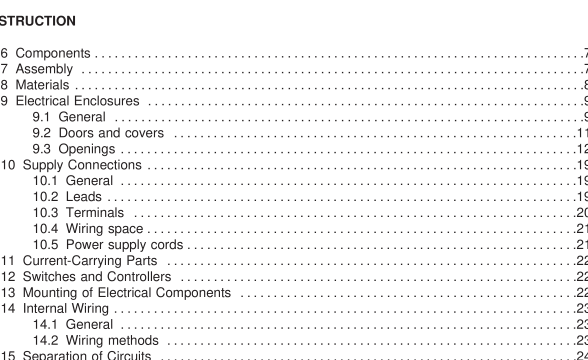UL 462-2010 pdf download.Heat Reclaimers for Gas-, Oil-, or Solid Fuel-Fired Appliances.
1 Scope 1 .1 These requirements cover heat reclaimers which are intended to recover a portion of heat from the flue gases of gas-, oil-, or solid fuel-fired appliances for the purpose of heating space or water. They are for installation on the vent or chimney connectors of the appliances which are for attachment to a Type B or Type L vent or a metal or masonary chimney. The heat reclaimers are covered for the maximum flue gas temperature marked on the heat reclaimer, which does not exceed 1 000°F (538°C). 1 .2 The heat reclaimers are intended for installation by a qualified agency in accordance with the manufacturer’s instructions and the Standard for Chimneys, Fireplaces, Vents, and Solid Fuel Burning Appliances, NFPA 21 1 or with the National Fuel Gas Code, NFPA 54/ANSI Z223.1 . 1 .3 These heat reclaimers intended for connection to an electrical supply are to be rated 240 volts or less, and are for installation in accordance with the requirements for ordinary locations in the National Electrical Code, NFPA 70. 1 .4 Heat reclaimers which include plumbing connections are to be installed in accordance with the applicable plumbing codes. 2 Components 2.1 Except as indicated in 2.2, a component of a product covered by this standard shall comply with the requirements for that component. See Appendix A for a list of standards covering components generally used in the products covered by this standard. 2.2 A component need not comply with a specific
3 Units of Measurement 3.1 Values stated without parentheses are the requirement. Values in parentheses are explanatory or approximate information. 4 Undated References 4.1 Any undated reference to a code or standard appearing in the requirements of this standard shall be interpreted as referring to the latest edition of that code or standard. 5 Glossary 5.1 For the purpose of this standard, the following definitions apply. 5.2 CHIMNEY CONNECTOR – The pipe which connects a fuel-burning appliance to a chimney. 5.3 COMBUSTIBLE MATERIAL, COMBUSTIBLE PRODUCTS, NONCOMBUSTIBLE MATERIALS – These terms, as used in this standard, are defined in the Standard Glossary of Terms Relating to Chimneys, Vents, and Heat-Producing Appliances, NFPA 97M. 5.4 DRAFT DIVERTER – (Also referred to as a Draft Hood.) A device built into a gas burning appliance or made a part of the vent connector from an appliance, which is intended to: a) Provide for the ready escape of the flue gases from the appliance in the event of no draft, back draft, or stoppage beyond the draft diverter, b) Prevent back draft from entering the heating appliance, and c) Neutralize the effect of stack action of the chimney or gas vent upon the operation of the appliance. 5.5 DRAFT REGULATOR, BAROMETRIC – A device which functions to maintain a desired draft in the oil-fired appliance by automatically reducing the chimney draft to the desired value.
7 Assembly 7.1 All components necessary for the intended function of the heat reclaimer shall be included with the product. 7.2 A joint in the metal surface of a heat reclaimer which forms a passageway for the flue gases shall be tight, as attained by being welded, lock-seamed, riveted, bolted, or equivalent means. A joint shall not depend primarily on cement for tightness. 7.3 A heat reclaimer shall be provided with means other than vent or chimney connection for support of the assembly when it is installed. 7.4 A heat reclaimer for oil- and solid fuel-fired appliances shall include means for cleaning the passageways for flue gases without having to disassemble the heat reclaimer. 7.5 With respect to 7.4, an independently removable access panel that can be removed and replaced by use of conventional tools without moving the heat reclaimer from its installed position is not considered disassembly. When closed, this access panel shall form a tight seal to prevent leakage of flue gases. 7.6 A heat reclaimer shall be constructed so there is no reduction in the total free venting area as compared to the cross-sectional area of a chimney or vent connector pipe on which the heat reclaimer is to be installed. Also, it shall not significantly impede the flow of vent gases. This is to be determined by tests in accordance with Draft Loss Test, Section 28.UL 462-2010 pdf download.
UL 462-2010 pdf download
